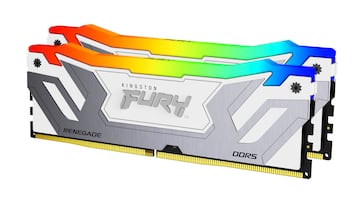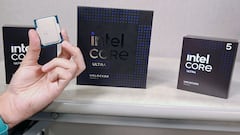Kingston FURY Renegade DDR5 CUDIMM, all you need to know about the new hardware
Compatible with Intel’s new 800 series chipset and the first platform to use Clock-Key-Drivers (CKD).

The new Kingston FURY Renegade DDR5 CUDIMM memory is designed for users looking for the latest DRAM technology to maximize system performance.
What’s new about the FURY Renegade DDR5 CUDIMM?
Apart from being compatible with Intel’s new ARC 800 series chipset and being the first platform to use Clock Drivers (CKD). In these new memories, JEDEC (Joint Electron Device Engineering Council) requires that DDR5 memory from 6400MT/s and up include a clock driver in UDIMM and SODIMM modules.
Therefore, to distinguish these advanced modules from standard DDR5 UDIMMs and SODIMMs, JEDEC has now named them CUDIMMs and CSODIMMs, respectively.
What is CUDIMM?
As standard DDR5 speeds continue to increase for the latest generation of desktop and notebook computers, stability and data integrity become critical issues that must be mitigated. As speeds increase, electronic noise and jitter become an issue that can lead to errors, data loss or system crashes. To address this challenge, JEDEC, the body charged with maintaining industry standards for memory, specified a new requirement for unbuffered DDR5 Dual Inline Memory Module (DIMM) and DDR5 Small Outline Dual Inline Memory Module (SODIMM) at the end of 2023. Since the introduction of 6400Mt/s DDR5, it is necessary to add the Client Clock Driver (CKD) component to the memory module to redirect the clock signal to minimize noise, jitter and total noise.
Clock signals, traditionally generated by the processor, are voltage and current signals that flow at a constant frequency, oscillating between high and low states. These signals allow components on the motherboard to synchronize so that data is sent and received on time. With the clock controller on the module, it generates its own clock signal to ensure accurate synchronization on the module.
To differentiate from older DDR5 modules that do not have a clock controller, JEDEC requires that a “C” for “Clocked” be added to indicate the inclusion of this component, hence the new CUDIMM and CSODIMM module types. This is an important distinction because CUDIMMs and CSODIMMs use the same slots as existing DDR5 UDIMMs and SODIMMs. To avoid compatibility issues, chipset and motherboard manufacturers will implement BIOS updates on older motherboards that disable the clock controller when a CUDIMM/CSODIMM is installed. When a CUDIMM or CSODIMM is installed in an older system, it will automatically run at the speed supported by that chipset and processor.
Related stories
This enhancement benefits a wide range of applications, from gaming and creative projects to scientific research and financial calculations where data accuracy is critical. The addition of the clock controller also opens new frontiers for overclocking speeds. Improved signal integrity enables higher speeds that remain stable under stress.
Clocked Unbuffered DIMMs (CUDIMMs) and Clocked Small Outline DIMMs (CSODIMMs) represent a significant advancement in memory technology to meet the growing demand for high-performance computing hardware. The addition of the clock controller to the module is just one example of how memory requirements continue to evolve and play an important role in achieving optimal system performance.


Complete your personal details to comment